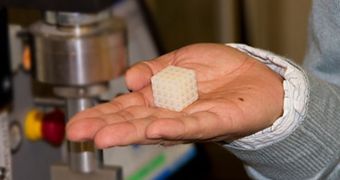Engineers looking for materials that stick to some very sensitive demands may finally get a reprieve, thanks to work carried out in United States. Experts here managed to develop a new method for producing materials that can be customized according to needs.
For example, customers might soon be able to order a composite material that is capable of a certain amount of energy dissipation, or that has a certain resistance to impact. Aspects such as strength and stiffness can be controlled as well.
All this is made possible by the work of experts at the Massachusetts Institute of Technology (MIT), in Cambridge. The “co-continuous” structures that the team developed allow two different materials to underly the same end product.
Generally, when selecting two materials with two different sets of properties, engineers use them separately. The MIT group took another approach, putting them together in an arrangement that allows the end product to borrow traits from both of its interlocking components.
When viewed close-up, the new composite material features a three-dimensional lattice that contains both individual components, but in a co-continuous arrangement. The materials are hooked up to each other from side to side, front to back, and top to bottom.
Funds for this research came from the US Army, via the MIT Institute for Soldier Nanotechnologies. The work was led by postdoctoral student Lifeng Wang, who collaborated with professors Mary Boyce and Edwin Thomas, and also with undergraduate student Jacky Lau.
Details of the new materials were published in paper that appeared in the April issue of the top scientific journal Advanced Materials. The entire study was informed by the need to “try to design a material that can absorb energy under extreme loading situations,” Wang reveals.
The new materials “could be lightweight and efficient, flexible, not just a solid mantle,” the expert adds. He was making reference to materials currently used to make airplanes and armored vehicles.
Commenting on the new achievement, US Air Force (USAF) official Richard Vaia said that this study is “an exciting demonstration of the crucial importance of architecture in materials-by-design concepts.”
Vaia holds an appointment as the acting chief of the Nanostructured and Biological Materials Branch, which is based at the Wright-Patterson Air Force Base, in Ohio,
The study also “provides an example of the future of composite and hybrid materials technology where direct-write fabrication, printing technologies and complex fiber-weaving techniques are not simply manufacturing tools, but an integral part of a robust, implementable digital design and manufacturing paradigm,” he concludes.

 14 DAY TRIAL //
14 DAY TRIAL //